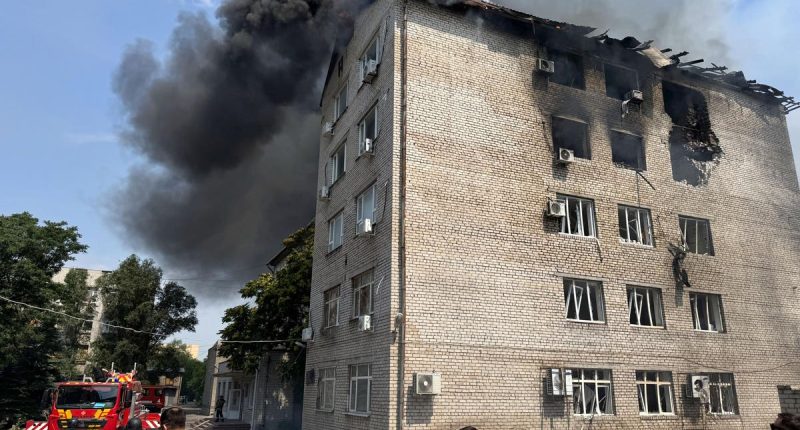Share this @internewscast.com
Black smoke rises over the area where a Russian attack drone lands near the Zaporizhzhia Regional … More
NurPhoto via Getty Images
Dispatches from Ukraine. Day 1,230.
Russian Attacks on Ukraine and War Developments
Late on July 3 and into the early hours of July 4, Russia battered Ukraine with more than 500 drones and missiles in the most intense aerial attack of the war, surpassing the previous record set just days earlier on June 29. Russian forces deployed 539 drones and decoys, the highest number simultaneously dispatched to date, along with 11 missiles directed at Ukraine’s capital, Kyiv. Ukraine’s Air Force intercepted 268 drones and two cruise missiles, as well as electronically jamming an additional 208 drones; however, none of the nine ballistic missiles were downed. Kyiv Mayor Vitali Klitschko reported two people killed and at least 24 injured.
In addition to massive overnight barrages, Russian daytime attacks killed at least 20 civilians across Ukraine on July 5-7. The embattled eastern Donetsk region suffered the heaviest losses, where systematic Russian shelling killed 12 residents and wounded 26 others. In northeastern Kharkiv oblast, or province, Russian strikes killed four people and injured 96 others; meanwhile, the governor of the southern province of Kherson reported four residents killed and 22 others injured.
The situation in the city of Kherson, is further exacerbated by daily Russian drone strikes that seem to deliberately target civilians. International advocacy group Human Rights Watch, released a detailed report documenting at least 45 drone attacks aimed at civilian targets in Kherson, which lies on the western bank of the Dnipro River, within close range of occupying Russian forces that control the eastern bank. The organization found evidence that Russian military operators using First Person View (FPV) drones could discern that they were targeting civilians, which would make the attacks deliberate and constitute crimes against humanity.
In total, Russia has rained more than 22,500 drones and decoys and 753 missiles down on Ukrainian cities since the beginning of 2025. Compared to the second half of 2024, Russian drone deployment has tripled, while missile launches declined by a quarter. Relative to 2023, Russia’s drone production has surged more than twentyfold; missile output, by contrast, has remained largely stagnant.
Russia is using its escalating drone attacks to try and degrade Ukraine’s mobilization efforts, Ukraine’s Ground Forces have said following recent Russian strikes on military recruitment centers. Most recently, Russian drones hit recruitment centers in the major cities of Kharkiv and Zaporizhzhia, wounding 14 military personnel. This follows a series of similar strikes across the country, including a July 3 drone hit on recruitment offices in the central Poltava region, which killed two people and injured 47 other victims. Ukrainian officials report that Russia’s campaign began earlier this year, initially involving sabotage attempts and bomb threats against enlistment centers.
Even as Russia unleashed its biggest attack on Ukraine to date on July 4, Ukraine in turn used drones to strike an airfield and other targets inside Russia. In an effort to limit Russia’s ability to carry out attacks, Ukraine attacked Borisoglebsk military airfield, in Russia’s Voronezh region on Ukraine’s eastern flank, striking a warehouse containing glide bombs,. Much further afield, in the city of Cheboksary, more than 700 miles east of Moscow, the General Staff of the Armed Forces of Ukraine said it successfully attacked a factory that manufactures critical components for guided weapons.
Ukrainian Government Reshuffle
Ukrainian President Volodymyr Zelenskyy discussed replacing Kyiv’s ambassador to Washington with U.S. President Donald Trump during a July 4 phone call. Among those reportedly under consideration to replace Oksana Markarova, who has been in her post since November 2020, are Prime Minister Denys Shmyhal, Deputy Prime Minister Olha Stefanishyna, Defense Minister Rustem Umerov, and Energy Minister German Galushchenko.
However, earlier reporting by Forbes Ukraine yielded a slightly different list of three primary candidates: Culture Minister Mykola Tochytskyi, Deputy Chief of Staff Ihor Zhovkva, and Defense Minister Umerov. Sources cited Tochytskyi as the front-runner due to his close ties to Zelenskyy’s aide Andriy Yermak and his long diplomatic resume, which includes experience working in the U.S.
Appointing a new ambassador, however, might weaken Ukraine’s diplomatic efforts in Washington amid strained relations with the Trump administration, which abruptly halted arms shipments to Kyiv, including badly needed Patriot missiles, which are in chronic shortage. The new envoy will likely need to spend considerable time building connections with officials in the current administration at a critical moment for the country.
Even bigger changes to the Ukrainian government might be coming. According to Britain’s weekly The Economist, a major government reshuffle in Ukraine appears imminent. Prime Minister Denys Shmyhal will likely be replaced by Deputy Prime Minister Yulia Svyrydenko, another politician viewed as close to Andriy Yermak. Svyrydenko had been among candidates being considered for the prime minister position last year, but the move was postponed. Now President Zelenskyy is reportedly preparing to consider her appointment again.
Culture Front
2000 Meters to Andriivka, a documentary by Oscar- and Pulitzer-winning journalist Mstyslav Chernov, opens in U.S. theaters later this month. The international trailer was released on July 7 and the film is premiering on July 25 in New York. It opens a week later in Los Angeles, before a national box office rollout; it is slated to air on PBS’s Frontline later this year. The documentary captures Ukrainian soldiers and their deadly fight to retake occupied Andriivka, a village in eastern Ukraine, during a failed 2023 counteroffensive. Blending frontline footage, bodycam video, and personal stories, the documentary provides a gut-wrenching glimpse into the brutal, raw reality of warfare.
Chernov, who directed 20 Days in Mariupol, a documentary about Russia’s siege of Mariupol and the first Ukrainian film to win an Oscar, said of the evolving nature of the conflict in Hollywood news site Deadline: “It’s much more roboticized, it’s much more inhuman, and the weapons even more precise. And it’s all about drones now.” Even after gaining international recognition, Chernov continues to document the war. Together with co-producer and cinematographer Alex Babenko, he is already working on his next film, which will capture the next phase of the war, shaped by drones and increasingly automated weapons.
By Danylo Nosov, Karina L. Tahiliani








